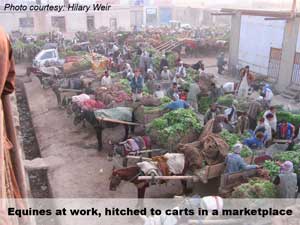ARCHIVE EQUINE NEWS STORIES
| Current news is available at TheHorsePortal.ca, Equine Guelph's online learning platform for practical, quick learning. Given the vast amount of information on horse health and welfare, Equine Guelph has archived its past news articles from 2002-2020. They are listed below, along with a search function available to find specific healthcare topics. | |
Doing the Donkey Work: Using Science to Improve Working Equine Welfare in Developing CountriesNovember 2009
By Kimberly Sheppard
Think of an equine.
Images of an animal peacefully grazing on pasture might come to mind. Or perhaps a relaxing trail ride, or a race at the local track. But images of an animal working long hours under harsh conditions with little in the way of health or veterinary care is not likely to be top of mind for most Westerners. Yet, an estimated 85% of horses, donkeys and mules live in developing countries where they are used for work, often under just such conditions.
Dr. Charlotte Burn of The Royal Veterinary College, together with The University of Bristol and The Brooke Hospital for Animals, UK, has been studying the welfare of working equines. Burn recently shared some of her research results in the CCSAW Animal Behaviour and Welfare Seminar Series.
 In developing countries, working horses, donkeys and mules are most often used for heavy labour, whether it be hauling heavy loads of cargo or carrying tourists up and down a mountain side. Conditions are harsh – it may be extremely hot or extremely cold with difficult terrain.
In developing countries, working horses, donkeys and mules are most often used for heavy labour, whether it be hauling heavy loads of cargo or carrying tourists up and down a mountain side. Conditions are harsh – it may be extremely hot or extremely cold with difficult terrain.
The animals may be suffering malnourishment, dehydration, disease, lameness or injury. Rest and recovery is often not a practical option. The animals have no choice but to continue working despite poor environmental or health conditions, as the livelihoods of their impoverished owners depend the steady work they do.
The good news is that many of the welfare problems faced by working equines are treatable and even preventable. This is where Burn’s work comes in. Her aim is to identify practical, sustainable solutions and interventions to the various problems, assess their effectiveness, and ultimately have the best solutions applied by equine owners themselves.
Burn and her colleagues conducted a survey of 10,843 equines in Ethiopia, the Gambia, Kenya, and Guatemala. She found that 85% could be classified as thin or very thin. The thinner animals were also lamer, and had more wounds and a greater incidence of diarrhea; 63% of animals had wounds with one quarter of these being deep enough to expose the muscle layer, or even the tendons and bones; 97% of animals had abnormal gaits.
All of these results indicate serious and ongoing welfare challenges that need addressing. One particular study was aimed at addressing a problem noted in tourist donkeys in Petra. These donkeys carry people up and down a mountain-side by saddle – the strap of which wraps under the base of their tails, sometimes rubbing away the skin and causing raw wounds. Burn surveyed the donkeys, and found tail-base lesions in 73% of 86 donkeys studied. She also found that dirty straps and straps padded with cotton or fleece made the problem worse. Simply using clean, synthetic straps and eliminating padding altogether is a realistic, sustainable intervention in this case.
Burn was also curious to know if equine behaviour could be used as a field indicator of physical welfare. She looked at a variety of behaviour, and found unresponsiveness and apathy to be associated with thinness, lesions, pale mucus membranes, diarrhea, old age, parasites, lameness, eye abnormalities, and missing teeth.
Thus, this behaviour can be considered a good first indicator of health conditions that are likely painful, or that may contribute to weakness and exhaustion. Such information can assist veterinarians in making quick judgments about animals in need of further assessment and possibly immediate care and intervention.
The results generated from studies such as these can be readily applied in field conditions to immediately improve the lives of working equines. Burn says a key to success is community participation in animal health and welfare initiatives. Two-way exchange of ideas, understanding community priorities, giving participants ownership of ideas, and providing expert feedback on efficacy all ensure the most successful outcome for the animals.
Burn continues to work with the University of Bristol and the Brooke Hospital toward reducing suffering of working equines.
"This article was originally published in CCSAW News, Issue 20. To read similar stories, please visit the 'Newsletter' section of Campbell Centre for the Study of Animal Welfare website: www.uoguelph.ca/ccsaw"